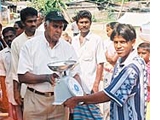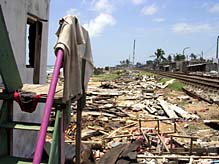
Destroyed settlement in Moratuwa. Most refugees in the camp had lived here.
|
In February 2005, SECONDAID started its first livelihood recovery projects at two sites, a refugee camp in Moratuwa, near the capital Colombo and at the south coast town of Tangalle. In both locations, government and NGOs have provided some food, living allowances and temporary housing. Yet, there has not been any support to livelihood recovery. As a result m The list summarizes materials distributed as of April 30, 2005. It illustrates the type of businesses in need, the materials we supplied and how little start-up capital is typically required. In early April, during a business trip to Sri Lanka, SECONDAID team members Gero Leson, Bernd Frank and Gordon de Silva, who with his daughter Sonali had made the contacts and initiated the work, visited our project sites to see for ourselves whether our work has been effective and to discuss next steps. We were very impressed with the work our partners have done so far with limited funds and under difficult circumstances. We were also pleased with how effective our simple concept has been in allowing people to resume their work.We now feel confident that we can expand our work to include larger items and enterprises with our remaining funds and with future donations. A summary of our experiences and impressions follows. 1. Refugee Camp Moratuwa
The government provides rice and lentils and a monthly allowance of $50 per family. However, other than SECONDAID, nobody gave the minimal funds needed to resume their work. Since early February, our team members have worked with the camp administrator to provide livelihood support to 25 families. Our team member Sonali Desilva Pandithasekera, whose university had asked its students to support tsunami victims made the initial contact with the camp administrator. Since Moratuwa is a center of carpentry, many of the victims were in that trade. Others were tree fellers, food vendors, plumbers, and fishermen. ... Photos from Moratuwa |
|||||||||||||||||
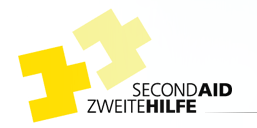







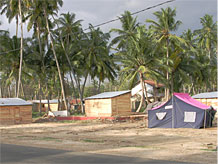 Tents and temporary wooden shelters near Bentota (west coast)
Tents and temporary wooden shelters near Bentota (west coast)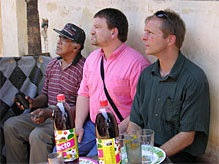 Team members Gero Leson, Bernd Frank and Gordon de Silva listening to people at Moratuwa camp.
Team members Gero Leson, Bernd Frank and Gordon de Silva listening to people at Moratuwa camp.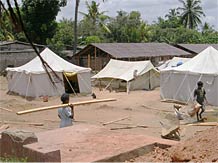 Tents and wooden shelters under construction in Moratuwa
Tents and wooden shelters under construction in Moratuwa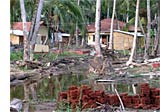 any displaced families, who are in camps or stay with relatives, have nothing to do. To fill this need, our local partners first surveyed then prioritized the needs of families with small businesses, compiled “shopping lists” of necessary items, purchased the materials locally, distributed them directly and followed up with the recipients. To date our donations of needed goods have helped approximately 100 families to resume their work, with typical amounts of $100 per family. Examples are fishermen, merchants, wood workers, tailors and food vendors.
any displaced families, who are in camps or stay with relatives, have nothing to do. To fill this need, our local partners first surveyed then prioritized the needs of families with small businesses, compiled “shopping lists” of necessary items, purchased the materials locally, distributed them directly and followed up with the recipients. To date our donations of needed goods have helped approximately 100 families to resume their work, with typical amounts of $100 per family. Examples are fishermen, merchants, wood workers, tailors and food vendors.